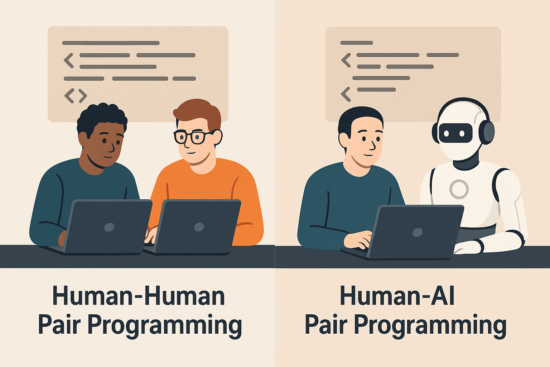In the not-so-distant past, pair programming was a scene straight from a startup’s open office: two developers hunched over a single keyboard, brainstorming, arguing over best practices, and together crafting lines of code late into the night.
Fast forward to today — one of those programmers is increasingly not human. It’s an AI.
AI Pair Programming isn’t just a buzzword. It’s changing the way we write software, collaborate across teams, and even think about what it means to “develop” software. Let’s dive into what AI pair programming really looks like today, why it’s transformative, and a real-world example you might see in action.

What Is AI Pair Programming?
Traditional pair programming involves two developers working together: one writes the code (“the driver”), while the other reviews each line as it’s typed (“the navigator”).
AI Pair Programming keeps this structure — but now, the “navigator” or even the “driver” can be an AI assistant trained on billions of lines of code, best practices, design patterns, and documentation.
Imagine pairing with a partner who:
-
Instantly suggests fixes for bugs.
-
Recommends cleaner, more efficient code.
-
Generates documentation as you type.
-
Even challenges your architectural decisions — politely.
That’s the reality of tools like GitHub Copilot, Amazon CodeWhisperer, Replit Ghostwriter, and new entrants like Cognition’s Devin, dubbed as the world’s first fully autonomous AI software engineer.
Real-World Example: Building a Django App with an AI Partner
Let’s say you’re building a Django application — a simple one where users can upload their resumes and search for job matches.
Without AI:
-
You manually set up views, URLs, models, templates.
-
You Google endlessly for snippets: “Django file upload best practices”, “How to preview uploaded file in Django”.
-
Debugging takes hours because a misplaced comma broke the form rendering.
With AI Pair Programming:
-
Autocomplete Assistance: As you create a Django model for file uploads, your AI suggests fields like
models.FileField(upload_to='resumes/')instantly. -
Error Catching: Missed a
csrf_tokenin your form? AI notices and suggests adding it before you even hit refresh. -
Architecture Advice: Thinking of storing resumes directly in the database? AI warns you: “Consider using file storage instead to avoid database bloat.”
-
Testing Boost: Need unit tests for your upload functionality? AI generates the first draft of tests automatically.
The result:
-
Project delivery time cut by 30-50%.
-
Code quality comparable to working with a senior developer.
-
More focus on creativity and feature-building, less on syntax battles.
Why Developers Love (and Sometimes Fear) AI Pair Programming
| Pros | Cons |
|---|---|
| Supercharges productivity | Risk of over-relying on AI |
| Improves code quality | AI can sometimes hallucinate wrong solutions |
| Accelerates learning | Security vulnerabilities if AI suggestions are blindly accepted |
| Reduces repetitive tasks | Potential to deskill junior developers if not balanced |
Like any powerful tool, AI pair programming works best when developers remain critical, engaged, and curious.
You are still the captain of the ship — AI is your turbocharged co-pilot.
A Mindset Shift: From Coders to Problem-Solvers
One fascinating trend AI pair programming is driving:
Developers are coding less and thinking more.
Instead of getting bogged down in boilerplate, developers are now:
-
Focusing on system design and user experience.
-
Asking bigger questions about scalability, performance, and maintainability.
-
Becoming architects and visionaries rather than just implementers.
In this sense, AI isn’t replacing developers.
It’s elevating them.
Final Words
AI Pair Programming is not a replacement — it’s an upgrade.
The smartest developers today aren’t the ones writing the most code — they’re the ones leveraging AI to build better software faster and smarter.
The future belongs to those who can collaborate, adapt, and create with their new AI teammates.
Are you ready to pair up?




